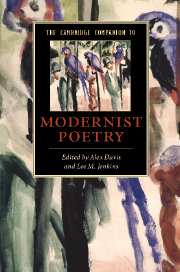Book contents
- Frontmatter
- Introduction
- Part I: Contexts
- Part II: Authors and Alliances
- 5 Pound or Eliot: whose era?
- 6 H.D. and revisionary myth-making
- 7 Yeats, Ireland and modernism
- 8 Modernist poetry in the British Isles
- 9 US modernism I: Moore, Stevens and the modernist lyric
- 10 US modernism II: the other tradition - Williams, Zukofsky and Olson
- 11 The poetry of the Harlem Renaissance
- 12 Caliban’s modernity: postcolonial poetry of Africa, South Asia and the Caribbean
- Part III: Receptions
- Guide to further reading
- Index
- Series List
9 - US modernism I: Moore, Stevens and the modernist lyric
from Part II: - Authors and Alliances
Published online by Cambridge University Press: 28 November 2007
- Frontmatter
- Introduction
- Part I: Contexts
- Part II: Authors and Alliances
- 5 Pound or Eliot: whose era?
- 6 H.D. and revisionary myth-making
- 7 Yeats, Ireland and modernism
- 8 Modernist poetry in the British Isles
- 9 US modernism I: Moore, Stevens and the modernist lyric
- 10 US modernism II: the other tradition - Williams, Zukofsky and Olson
- 11 The poetry of the Harlem Renaissance
- 12 Caliban’s modernity: postcolonial poetry of Africa, South Asia and the Caribbean
- Part III: Receptions
- Guide to further reading
- Index
- Series List
Summary
'Wallace Stevens is beyond fathoming, he is so strange; it is as if he had a morbid secret he would rather perish than disclose and just as he tells it out in his sleep, he changes into an uncontradictable judiciary with a gown and a gavel and you are embarrassed to have heard anything.' Was there ever such an instance of the pot calling the kettle black? Moore's poems too seem to harbour a secret behind their complicated surfaces, and in her work as well one feels the brisk, moral conclusions are a bit too abrupt, and not completely transparent as summaries of the prismatic turns that precede them. Despite her intense 'capacity for fact' which won the admiration of Objectivists such as William Carlos Williams and Louis Zukofsky, Moore's sensibility, and even her idea of what poetry is, brings her closer to the abstract, philosophical Stevens. 'No fact is a bare fact, no individual fact is a universe in itself', wrote Stevens, celebrating Moore's creation of 'an individual reality' out of the diversity of idiom and image that is the record of the world imagined. The task of the poet is to bring 'the thing' into an aesthetic integration where it takes on the character of an artist's world, created or discovered. Moore recognised early that Stevens too was creating such an 'individual reality'. She was one of the first to appreciate Harmonium in her review 'Well Moused, Lion', in which she admires the 'riot of gorgeousness' in his imagination. 'One is excited by the sense of proximity to Java peacocks, golden pheasants, South American macaw feather capes, Chilcat blankets, hair seal needlework, Singalese masks, and Rousseau's paintings of banana leaves and alligators.
- Type
- Chapter
- Information
- The Cambridge Companion to Modernist Poetry , pp. 163 - 180Publisher: Cambridge University PressPrint publication year: 2007
- 2
- Cited by



